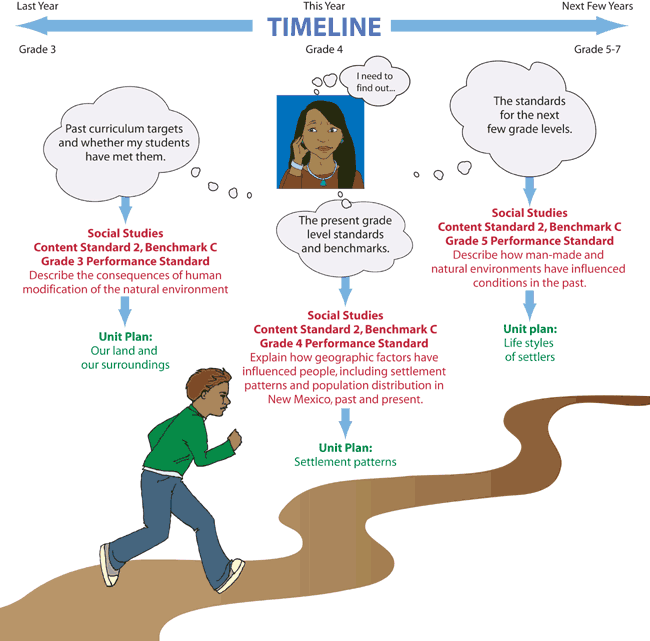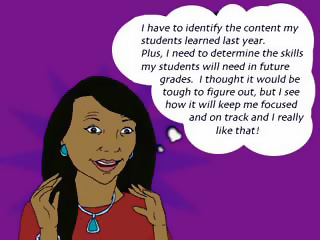What should Ms. Begay know about creating effective lesson plans?
Page 12: Curriculum Mapping
As a teacher, Ms. Begay must ask herself:
- What the students have been expected to learn during their past school years?
- What the students are to learn during the present school year?
- What they are going to be required to learn in future grades?
For example, if the student must learn how to apply his or her knowledge of water resources and their impact on the Southwest, Ms. Begay needs to develop her lessons in a way that breaks the learning process into steps. She must provide practice for her students based on the information they have already acquired and what she is currently teaching. She must also prepare them for skills they must have in the future.
The graphic below illustrates curriculum mapping. Take note of the unit plans that have been added to the timeline.

This graphic represents a timeline of Ms. Begay’s thinking about her curriculum mapping. It includes both text and images. At the top of the graphic is the title “TIMELINE,” written in blue bold and all-capital letters. Above this title, in black, is the text, “This Year,” and below the title is the text “Grade 4.” There is a blue arrow stemming from this title in both directions. On the far left side of the arrow is the text “Last Year Grade 3.” On the far right side of the arrow is the text “Next Few Years Grades 5–7.” Directly below the TIMELINE title is an image of Ms. Begay, who has olive skin and long black hair. She has a concerned look on her face and is resting her head on her hand. There is a thought bubble above her head that says, “I need to find out…” There is a thought bubble to the left of her image, underneath the left arrow that says, “Past curriculum targets and whether my students have met them.” A blue arrow pointing down from this thought bubble states in red “Social Studies Content Standard 2, Benchmark C Grade 3 Performance Standard Describe the consequences of human modification of the natural environment.” Another blue arrow points down from this red text to the green text stating “Unit Plan: Our land and our surroundings.” There is a thought bubble below Ms. Begay’s image that reads “The present grade level standards and benchmarks.” A blue arrow pointing down from this thought bubble states in red “Social Studies Content Standard 2, Benchmark C Grade 4 Performance Standard Explain how geographic factors have influenced people, including settlement patterns and population distribution in New Mexico, past and present.” Another blue arrow points down from this red text to the green text stating “Unit Plan: Settlement patterns.” The last thought bubble is to the right of Ms. Begay’s images and says, “The standards for the next few grade levels.” There is a blue arrow pointing down from this thought bubble stating in red “Social Studies Content Standard 2, Benchmark C Grade 5 Performance Standard Describe how man-made and natural environments have influenced conditions in the past.” Another blue arrow points down from this red text to green text stating “Unit Plan: Life styles of settlers.” Below all this text is large graphic, spanning the length of the timeline, of a boy wearing a green jacket and gray pants running down a long, winding, brown trail.
What is Curriculum Mapping?
Curriculum mapping is a tool used to gather information about what has been taught in a classroom over a specific period of time. Individual teachers can use curriculum maps to check what has been taught in a specific classroom, and groups of teachers in a specific grade level can use them to compare what students are being taught across all classes.
Why is Curriculum Mapping Important?
 It ensures that what is being taught in the classroom matches what has been specified in the curriculum.
It ensures that what is being taught in the classroom matches what has been specified in the curriculum.- It helps teachers to stay on track and accomplish the pacing goals they set at the beginning of the year.
- It helps to avoid redundancies in the curriculum.
- It encourages consideration of the instructional methods used by teachers to accomplish objectives.
- It helps to promote curriculum integration.